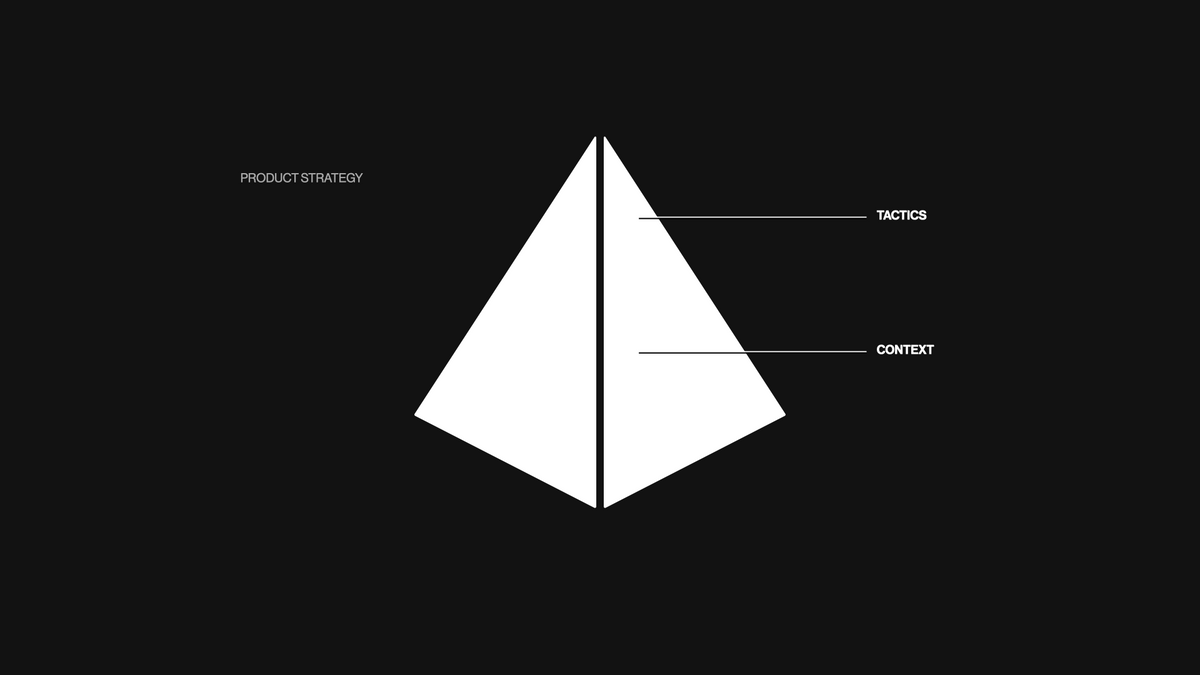4 Key Components of Product Strategy
Developing a winning product takes much more than just having a great idea. Crafting an effective product strategy that aligns to your business goals is essential to navigate the winding road from concept to launch and beyond.

Launching a successful new product requires much more than just having a great idea. You need a thoughtful strategy that transforms your vision into reality in the messy world of customers, competitors, and markets.
The four key components are:
- Understand Customers and the Market
- Define the Vision and Roadmap
- Develop the Right Offerings
- Deliver Value and Gathering Feedback
Deep dive more about strategy and get templates in the FREE ultimate guide to product strategy.

A strong product strategy acts like a compass to orient your efforts, navigate potential pitfalls, and chart the roadmap ahead.
In this article, you will learn:
- The four key components that make up a structured product strategy
- How to align your product aims to wider business goals
- Methods for understanding your target customer and market
- The importance of defining your product vision and rollout roadmap
- Key steps when developing your product offerings
- How to iterate based on user feedback post-launch
With the right product strategy, you can map out a path to launch, growth, and continued success. Let’s explore the essential foundations for crafting a strategy that takes you from concept to winning product.
Key Components of Product Strategy
Crafting a successful product from idea to launch and beyond requires careful planning and preparation. While enthusiasm and good intentions are great, they need to be channeled strategically.
An effective product strategy provides this direction by breaking down the journey into four key interlinked components:
- Understanding Customers and the Market
- Defining the Vision and Roadmap
- Developing the Right Offerings
- Delivering Value and Gathering Feedback
Getting these elements right lays the groundwork for product-market fit, step-by-step progress, and continuous improvement. Aligning efforts to a cohesive strategy, versus moving forward blindly, makes the difference between success and failure.
Let's explore each of these components in more detail to understand why they are mission-critical waypoints on the road ahead.
Understanding Customers and the Market
Thorough market research provides the fuel for your product strategy. Take time upfront to fully understand target users and the competitive landscape.

Useful activities include:
- Customer interviews - Directly engage with your target audience via 1-on-1 interviews. Probe their needs, pain points, and workflow.
- Surveys - Collect input from a wider sample through online surveys. Get quantitative data on preferences.
- Focus groups - Facilitate group discussions with 6-8 participants from your target segment. Uncover deeper insights.
- Competitor analysis - Research competitive products in depth. Map out strengths, weaknesses, opportunities and threats (SWOT).
- Market research - Leverage secondary market data reports to size opportunities, trends, and growth areas.
- User testing - Observe first-hand how customers interact with existing solutions. Identify usability issues.
- Data analysis - Analyze usage metrics if taking over an existing product. Spot areas for improvement.
The goal is to develop true empathy for the user experience and market dynamics. This understanding informs which ideas to pursue and problems to solve. It also prevents developing solutions for non-issues. Embrace empathy, patience, and deep listening.
Defining the Vision and Roadmap
With research insights in hand, synthesize learnings into a compelling product vision and strategic roadmap. Translate research insights into a compelling product vision that aligns to your overarching business strategy and objectives:
- Product vision - Craft an inspiring vision statement for where you want to take the product long-term. Align to business strategy.
- Strategic objectives - Outline the key business and customer objectives you aim to achieve through the product.
- Roadmap - Plot out a phased rollout plan with key stages and milestones. Prioritize ruthlessly.
- Release planning - Map out release plans detailing the features, resources, and marketing initiatives for each launch.
- Budgets - Develop detailed budgets for engineering, marketing, operations, and other functions. Model cash flows.
- Success metrics - Define quantitative metrics and KPIs to track progress towards objectives.
Having a detailed roadmap and release plans prevents haphazard efforts and provides critical guidance when trade-offs arise. It also enables coordination across teams towards shared goals.
Revisit the roadmap regularly as a steering tool. Be ready to adapt based on market feedback and learnings from testing. The map is not the terrain.
Developing the Right Offerings
With your roadmap defined, make strategic decisions regarding your product mix and offerings:
- Core product - Outline the key features and functionality of your main product based on customer needs.
- Product line - Determine extension products, upgrades, or "flavours" to target additional segments.
- Freemium model - Consider offering a free version alongside paid plans to drive adoption.
- Packaging and pricing - Bundle features into packages and tiers based on value to users. Price strategically.
- MVP launch - Release a minimum viable product to validate assumptions and get real-world feedback.
- Innovation pipeline - Maintain an innovation pipeline of potential new offerings to evaluate.
- Sunset strategy - Decide when to retire aging products to focus resources on priority items.
- Partnerships - Identify partnership opportunities to augment capabilities rather than building in-house.
Avoid feature bloat and over-engineering. Seek to delight users with well-designed experiences that solve key jobs-to-be-done. Offerings will evolve based on continuous learning.
Delivering Value and Gathering Feedback
The core product strategy mindset is learning and iteration based on real customer data. Useful practices include:
- Early testing - Conduct usability tests even before launch to gather feedback and refine the product.
- Low-fi MVPs - Launch simplified, low-fidelity MVPs first to test assumptions before investing in full build outs.
- Try before you buy - Offer free trials or freemium models to reduce barriers to adoption.
- Onboarding - Optimize the onboarding process to successfully activate new users.
- In-app messaging - Use prompts and cues to guide users to key workflows and features.
- Feature engagement - Track feature and content usage to double down on highly engaged elements.
- User interviews - Continuously interview real users to identify areas for improvement.
- Surveys - Use in-app surveys to gather quantitative feedback from both active and churned users.
- Analytics - Instrument events to derive insights from usage data and guide development priorities.
- Agile processes - Employ agile, iterative techniques to regularly release and refine based on learnings.
By taking a test-and-learn approach, you can work to align features to customer needs rather than hunches. Be evidence-driven.
3 Ways to Develop a Successful Product Strategy
Following these three practices helps ensure your product strategy is rooted in real customer and market needs. Align your efforts to genuine problem-solution fit, not hypothetical assumptions. Adopt a test and learn mindset.
Conduct Competitive Analysis
Thoroughly research competitive products, features, pricing, and target users. Identify gaps in the market, opportunities to differentiate, and areas where competitors fall short. Use tools like competitive matrixes to map the landscape. Analysis provides insights to inform your strategy and product decisions.
Gather Customer Insights
Go beyond market research by directly engaging target users. Conduct interviews and focus groups to identify pain points and unmet needs. Observe how they currently solve problems. Empathize with their motivations. Deep customer insights ensure you build products they want and will use.

Test and Validate with Customers
Start testing early with minimum viable products to validate product-market fit. Gather user feedback through techniques like prototype testing and customer advisory boards. Be ready to iterate or pivot based on learnings. Validated learning with real customers reduces risk and uncertainty.
In the arena, the road to greatness
The road from initial concept to successful product is filled with twists and turns. Things rarely go smoothly or as planned on paper. However, by embracing a structured product strategy, you can equip yourself with the compass needed to navigate uncertain terrain.
First, invest time to deeply understand your target customers and the competitive landscape. Let empathy and evidence guide your efforts. Next, define a long-term vision and phased roadmap aligned to business objectives. Make strategic choices on offerings, release plans, and budgets.
Launch MVP products early to gather real-world feedback. Remain nimble; refine based on usage data and user input. Measure progress with quantitative KPIs, but also stay open to qualitative insights. Expect challenges, but persist.
With the right product strategy, you can chart a path to success even in uncharted waters. Gain clarity on where you are, where you want to go, and how to get there.
The journey will be arduous, but immensely rewarding. Time to pack your bags and hit the road. The adventure awaits.

